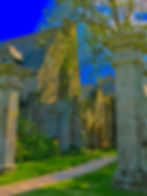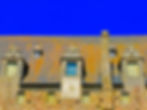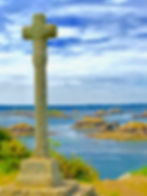La Bretagne (Brittany)
- Kate Woodman
- Jun 4, 2019
- 6 min read
Updated: Feb 16, 2020

Le port de Paimpol
La semaine dernière j’ai échangé les quais de la Seine pour le côtes bretonne. Même si j’aime Paris, c’était un changement bienvenu ! Le propriétaire de mon appartement a grandi en Bretagne, donc je lui ai démandé où je devrais aller. Elle a proposé le petit port de pêche, Paimpol. Donc c’est où je suis allée et ça m’a beaucoup plu.
Last week I exchanged the banks of the Seine for the coastline of Brittany. Much as I love Paris, I needed a change…and Brittany was a most welcome one. My landlord grew up there, so I asked her where I should go. She suggested the small fishing port town of Paimpol, located in the region of Côtes d’Armor (sea coast….côtes is French for “coast” and ar mor is Breton for “the sea”). I knew the Côtes d’Armor as a great place for long walks by the sea, so I accepted her suggestion and was soon on the train to Paimpol.

Breton coast
Paimpol est située dans le département des Côtes-d'Armor. Construite autour de ses bassins, Paimpol est l'un des principaux ports de pêche et de plaisance donnant sur la Manche. Les Côtes-d’Armor est bien connu pour les splendeurs de son littoral et la mer. De plus, il y a le GR- 34 qui borde l’ensemble des côtes bretonnes sur plus de 2000 kilomètres. Ce sentier était situé à côté de l’appartement où j’ai séjourné.
Though small (population 7000), Paimpol is one of the principal fishing ports on the French side of the English Channel. It also has its fair share of luxury sail boats docked in its port. But I wasn’t interested in fishing and didn’t know anyone with a sailboat. It was the lure of GR-34 that drew me there. GR is the abbreviation of Grande Randonnée (great hike). The Grande Randonnée (French), Grote Routepaden or Lange-afstand-wandelpaden (Dutch), Grande Rota (Portuguese) or Gran Recorrido (Spanish) is a network of long-distance footpaths in Europe, mostly in France, Belgium, the Netherlands and Spain. GR-34 runs along the Breton coast for more than 2000 kilometers (1242 miles), including right next to the building in Paimpol where I stayed.

Fishing boat

Sail boats in the harbor

GR-34 next to the building where I stayed
Le premier jour à Paimpol (je suis arrivée vers 15h), j’ai pris le sentier à côté de mon bâtiment, qui est à côté de la Baie de Paimpol. Mes amis m’ont dit de la marée en Bretagne. Je pensais connaître les marées (comme Long Island Sound). Mais les marées de LISound n’est pas comme les marées de Bretagne. À 15h, c’ètait la marée basse. Il n’y avait aucun eau pour kilometres ! Il y avait les bateaux qui ont été fondés, et les plages mais aucun eau. J’ai vu l’eau au loin et mon but était de marcher jusqu’à l’eau. J’ai marché plus d’une heure, à la fin de la Pointe de Guilben, mais encore il n’y avait pas d’eau. Je me suis retourné et je suis revenu à l’appartement. Je suis allé au dîner et quand je suis retourné, il y avait la marée haute et, voila, la baie était plein d l’eau.
My first day (I arrived around 3pm), I took the path (GR-34) next to the building where I stayed. This path is next to the Bay of Paimpol. My friends had told me (indeed WARNED me) about the tides in Brittany. I thought I knew tides as I’ve spent a fair amount of time on tidal Lond Island Sound. But the tides of the Sound are not like the tides of Brittany! At 3pm, it was low tide. There was no water for miles! Boats were leaning on their sides and there were beaches but no water. I could see water in the distance, so my goal was to walk to the water. I walked more than an hour to the end of Point Guilben, but still there was no water. It was getting late, so I turned around and went back to the apartment. I went to dinner and when I returned, the tide had come in and, low and behold, the bay was full of water!

Boat grounded by low tide

Beach but no water....school class on a sport outing

An almost lunar landscape....

They don't care about the tide!



Lots of pine trees by the coast...

Bay of Paimpol after dinner at high tide
Le deuxième jour, j’ai randonné sur le GR-34 au petit village de Kérity voir l’Abbaye de Beauport, qui est peut-être le plus connu lieu historique dans la région. Fondé par l'ordre des Prémontrés en 1202, face à la mer, le site témoigne de huit siècles d'histoire. Chaque époque, monastique ou laïque, y a laissé sa marque, de l'architecture gothique élégante aux jardins de roses. Pour moi, ce sont le caractère grandiose de ses ruines et le milieu littoral que m’ont plu le plus. C’est un lieu de beauté naturelle et de charme romantique.
The second day, I hiked along the GR-34 to the small village of Kérity to see Beauport Abbey, which is perhaps the best-known of the historic sites in the region. The abbey was founded in 1202 by an order of Premonstratensian monks. The Roman Catholic order of Prémontrés was founded in the early 12th century by St. Norbert in Prémontré France. The abbey is beautifully sited facing the Bay of Paimpol and embraces eight centuries of history. Each chapter of its history, monastic or lay, has left its mark, from the elegant Gothic architecture to the apple orchard and 18th century-style walled garden. For me, it was the coastal setting and simple grandeur of the Gothic ruins that I found most stunning....a place of natural beauty and romantic charm.

Beauport Abbey

The church - Gothic Norman Romanesque style


Love the flowers growing in the ruins....

Exterior church wall

Elegant calla lilies

More calla lilies

Herb garden in what was the kitchen

View of the bay at low tide


The orchard with espaliered fruit trees

Lay brothers wing with dormitory, refectory and visiting rooms

Roses in the garden
Ma sortie préférée cependant était mon jour sur l'Île de Bréhat, une commune située dans le département des Côtes-d'Armor au nord de la pointe de l'Arcouest. On prends les Vedettes de Bréhat de l'Arcouest à l'île. Bréhat est connu pour le granite rose, son doux microclimat, et sa végétation méditerranéenne qui favorise une très grande diversité de fleurs et de plantes. Les géraniums grimpent le long des façades des maisons. On y trouve même des palmiers. C'est vraiment formidable et spectaculaire! Et c'est une île piétonne ... il n'y a pas de voitures, motos ou trottinettes électriques.
My favorite outing was the day I spent on the island of Bréhat. I took a bus to the small town of Arcouest and then a quick ferry to Bréhat.
Bréhat is actually an archipelago composed of two main islands, separated only at high tide, and many smaller ones. It is famous for its pink granite rocks, very mild micro-climate and Mediterranean vegetation, due to the warm Gulf Stream coming from across the Atlantic. The lush and colorful flowers and vegetation were spectacular. AND it's a pedestrian island....no cars, motorcycles or electric scooters (gr-r-r-r!)....only the occasional velo (bike)!

Île de Bréhat


Moulin à mer Étang (water mill)


Water wheel

Seagull on thatched roof of watermill

Croix de Maudez

Chapel of Saint Michel

Typical "street" of Bréhat
Flowers of Bréhat







Houses of Bréhat









Walking back to my apartment after dinner on my last night in Paimpol, I happened upon a photoshoot of a handsome young man and a chicken.

Upon returning to my apartment, I discovered that the handsome young man is local celebrity Guirec Soudée and his chicken Monique. Guirec is a 25-year-old sailor from nearby Plougrescant who recently sailed around the world on his sailboat, Yvinec, accompanied by his red hen, Monique. Ironically, the day before I saw this chicken painted on the bow of a docked sailboat. I noticed, but did not read carefully, a plaque on the boat which said something about the boat making a long trek....obviously it was the Yvinec and the painted chicken was Monique!


The charming port of Paimpol by day....

....and at sunset
Beautiful Brittany....I shall return!
